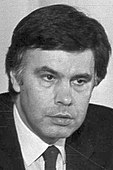Spanish local elections, 1995
|
|
|||||||||||||||||||||||||||||||||||||||||||||||||||||||||||||||||||||||||||||||||||||
|---|---|---|---|---|---|---|---|---|---|---|---|---|---|---|---|---|---|---|---|---|---|---|---|---|---|---|---|---|---|---|---|---|---|---|---|---|---|---|---|---|---|---|---|---|---|---|---|---|---|---|---|---|---|---|---|---|---|---|---|---|---|---|---|---|---|---|---|---|---|---|---|---|---|---|---|---|---|---|---|---|---|---|---|---|---|
|
|||||||||||||||||||||||||||||||||||||||||||||||||||||||||||||||||||||||||||||||||||||
|
65,869 councillors in 8,067 municipal councils 1,034 seats in 38 provincial deputations |
|||||||||||||||||||||||||||||||||||||||||||||||||||||||||||||||||||||||||||||||||||||
| Registered | 31,953,812 |
||||||||||||||||||||||||||||||||||||||||||||||||||||||||||||||||||||||||||||||||||||
| Turnout | 22,324,852 (69.9%) |
||||||||||||||||||||||||||||||||||||||||||||||||||||||||||||||||||||||||||||||||||||
|
|||||||||||||||||||||||||||||||||||||||||||||||||||||||||||||||||||||||||||||||||||||
The 1995 Spanish local elections were held on Sunday, 28 May 1995, to elect all 65,869 councillors in the 8,067 municipalities of Spain and all 1,034 seats in 38 provincial deputations. The elections were held simultaneously with regional elections in thirteen autonomous communities, as well as local elections in the three foral deputations of the Basque Country and the ten island councils in the Balearic and Canary Islands.
Municipalities in Spain were local corporations with independent legal personality. They had a governing body, the municipal council or corporation, composed of a mayor, deputy mayors and a plenary assembly of councillors. Voting for the local assemblies was on the basis of universal suffrage, with all nationals over eighteen, registered in the corresponding municipality and in full enjoyment of all political rights entitled to vote. The mayor was in turn elected by the plenary assembly, with a legal clause providing for the candidate of the most-voted party to be automatically elected to the post in the event no other candidate was to gather an absolute majority of votes.
Local councillors were elected using the D'Hondt method and a closed list proportional representation, with a threshold of 5 per 100 of valid votes—which included blank ballots—being applied in each local council. Parties not reaching the threshold were not taken into consideration for seat distribution. Councillors were allocated to municipal councils based on the following scale:
...
Wikipedia






